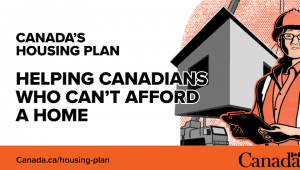Timely Analysis Compares Liberal and Conservative Housing Plans Ahead of Canadian Federal Election 2025
Ecohome publishes an in-depth, nonpartisan breakdown of the major parties’ housing policies to help Canadian voters make informed decisions.
The guide, available as a detailed breakdown of Liberal and Conservative housing plans, analyzes each party's proposed strategies on affordability, green building incentives, zoning reform, tax policies, and housing supply. It also considers the broader implications these policies may have on Canadians, developers, and future generations.
“Housing affordability is top of mind for Canadians, and it’s essential that voters understand how each party plans to address this issue”, said Robert J. Pierson, CEO of Ecohome Network Inc. “Our goal is to provide a clear, unbiased comparison to support voter education and spark meaningful discussion.”
One key theme explored in the article is collaboration in housing delivery - including partnerships with non-profits, co-operatives, private developers and Indigenous communities. As Canada seeks long-term solutions, experts increasingly advocate for community-led, inclusive development models - an area where the major parties’ commitments diverge.
“True progress on housing requires collaboration - not just between federal and provincial governments, but with Indigenous leaders, community organizations, and local builders”, Mike Reynolds, co-founder and editor-in-chief of Ecohome added. “We believe the future of affordable housing must be inclusive and participatory.”
Released during the early stages of campaigning, the analysis offers timely insight into the core differences shaping Canada’s housing future - and the choices voters face at the ballot box. Beyond the political implications, the housing sector plays a critical role in Canada’s economic stability, with construction and real estate representing more than 20% of GDP. Ongoing pressures from supply chain disruptions and U.S. lumber tariffs - amplified by trade tensions under former President Donald Trump - continue to inflate building costs and delay projects nationwide.
As policymakers and builders search for scalable, cost-effective solutions, prefabricated construction is also gaining renewed attention. Innovations in this space are seen as a way to accelerate housing delivery, reduce waste, and insulate the sector from volatile material costs. Ecohome explores these benefits and market trends further in its comprehensive guide to prefab homes in Canada.
Karen Bunz
2iiS Marketiing Inc
+1 604-445-1211
email us here
Visit us on social media:
Facebook
X
LinkedIn
Instagram
YouTube
Other
Legal Disclaimer:
EIN Presswire provides this news content "as is" without warranty of any kind. We do not accept any responsibility or liability for the accuracy, content, images, videos, licenses, completeness, legality, or reliability of the information contained in this article. If you have any complaints or copyright issues related to this article, kindly contact the author above.
Warehouse Robotics Market to Reach $31,343.7 Million by 2032 at 18.2% CAGR: Allied Market Research
Nano Gold in India Market Growth Analysis Report with Future Business Scope and New Investment Plans by 2027
Packaging and Protective Packaging Market to Reach USD 1.5 Billion by 2031, Expanding at a Steady CAGR of 4.3%
Kalendarium
Więcej ważnych informacji
 Jedynka Newserii
Jedynka Newserii

 Jedynka Newserii
Jedynka Newserii

Prawo

KE proponuje nowy Fundusz Konkurencyjności. Ma pobudzić inwestycje w strategiczne dla Europy technologie
W środę 16 lipca Komisja Europejska przedstawiła projekt budżetu na lata 2028–2034. Jedna z propozycji zakłada utworzenie Europejskiego Funduszu Konkurencyjności o wartości ponad 400 mld euro, który ma pobudzić inwestycje w technologie strategiczne dla jednolitego rynku. Wśród wspieranych obszarów znalazła się obronność i przestrzeń kosmiczna. Na ten cel ma trafić ponad 130 mld euro, pięciokrotnie więcej niż do tej pory.
Firma
Były prezes PGE: OZE potrzebuje wsparcia magazynów energii. To temat traktowany po macoszemu

Choć udział odnawialnych źródeł energii w miksie energetycznym Polski jest stosunkowo wysoki i rośnie, to ten przyrost jest chaotyczny i nierównomiernie rozłożony miedzy technologiami – wskazuje Forum Energii. Dodatkowo OZE potrzebują wsparcia magazynów energii, a zdaniem Wojciecha Dąbrowskiego, prezesa Fundacji SET, ten temat jest traktowany po macoszemu. Brak magazynów powoduje, że produkcja energii z OZE jest tymczasowo wyłączana, co oznacza marnowanie potencjału tych źródeł.
Infrastruktura
Wzrost wynagrodzeń ekip budowlanych najmocniej wpływa na koszty budowy domu. Zainteresowanie inwestorów mimo to nieznacznie wzrasta

Budowa metra kwadratowego domu w Polsce kosztuje od 5,55 do 6 tys. zł w zależności od województwa – wynika z najnowszych analiz firmy Sekocenbud. Najdrożej jest w Warszawie, gdzie cena za metr kwadratowy domu przekroczyła już 6,2 tys. zł. Na przyrosty kosztów budowy domu wpływają zarówno drożejące materiały budowlane, jak i wyższe wynagrodzenia pracowników. Inwestorzy nie rezygnują jednak z budowy domów jednorodzinnych, co ma związek m.in. z wciąż wysokimi cenami mieszkań czy też obniżką stóp procentowych.
Partner serwisu
Szkolenia

Akademia Newserii
Akademia Newserii to projekt, w ramach którego najlepsi polscy dziennikarze biznesowi, giełdowi oraz lifestylowi, a także szkoleniowcy z wieloletnim doświadczeniem dzielą się swoją wiedzą nt. pracy z mediami.











.gif)

 |
| |
| |
|